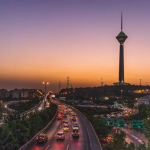Zayandeh Rood is one of the most famous and historic rivers in Iran. It originates from the Zagros Mountains and flows through the central plateau of Iran, passing through several cities, including Isfahan, before eventually flowing into the Gavkhouni wetland. The river is a symbol of life and fertility in the region and has played a significant role in the history and culture of Iran.
The history of Zayandeh Rood

“Zayandeh Rood” is a Persian term that can be translated as “life-giving river” or “river of life.” The name reflects the importance of the river to the region, as it has historically provided water for irrigation, drinking, and other purposes, and has supported the development of agriculture and civilization in the area.
Zayandeh Rood has been an essential source of water for the people of Iran for centuries. The river has been used for irrigation, transportation, and fishing, and has been an integral part of the region’s economy and culture. The river has also been a significant factor in the growth and development of several cities, including Isfahan, which was once the capital of Iran.
The river’s banks are home to many historic and cultural sites, including bridges. The river has also been a source of inspiration for poets and artists throughout history, and its beauty and majesty have been celebrated in literature and art for centuries.
If you’re also excited to visit this beautiful city and join us on our next trip, click now!
Tour Category: Iran Culture Tours 2025
Exploring Zayandeh Rood
Zayandeh Rood is a popular destination for tourists and locals alike, offering a wide range of attractions. There are several bridges that cross the river, including Khaju Bridge and Si-o-se-pol Bridge, both of which are famous for their beautiful architecture and historic significance.
The importance of Zayandeh Rood
Zayandeh Rood is not only important for its practical uses but also for its cultural and artistic significance. The river has been a significant factor in the development of the region’s architecture, art, and literature. The river has also been a source of inspiration for many artists and poets.
Does Zayandeh Rood have water?
Zayandeh Rood river in Isfahan dried up due to reckless water pumping, multi-year drought, reduction in water transfer from Karun River, wrong management, transfer of major industries, inappropriate cultivation patterns, and water transfer projects. The river completely dried up in some periods, leading to the displacement of migratory birds and risks to historical bridges. Its death means the death of a civilization that is several hundred years old, impacting tourism and forcing hundreds of thousands of people downstream to migrate. “Zayandeh Rood Commemoration Day” on October 10 raises awareness about this issue.
Last word
Zayandeh Rood is a symbol of Iran’s history, culture, and resilience. The river has played a significant role in the development of the region’s architecture, art, and literature, and has been a source of inspiration for many artists and poets.
Let us know your ideas and comments about this —- in the comment box below, we will be happy to hear from you!


















